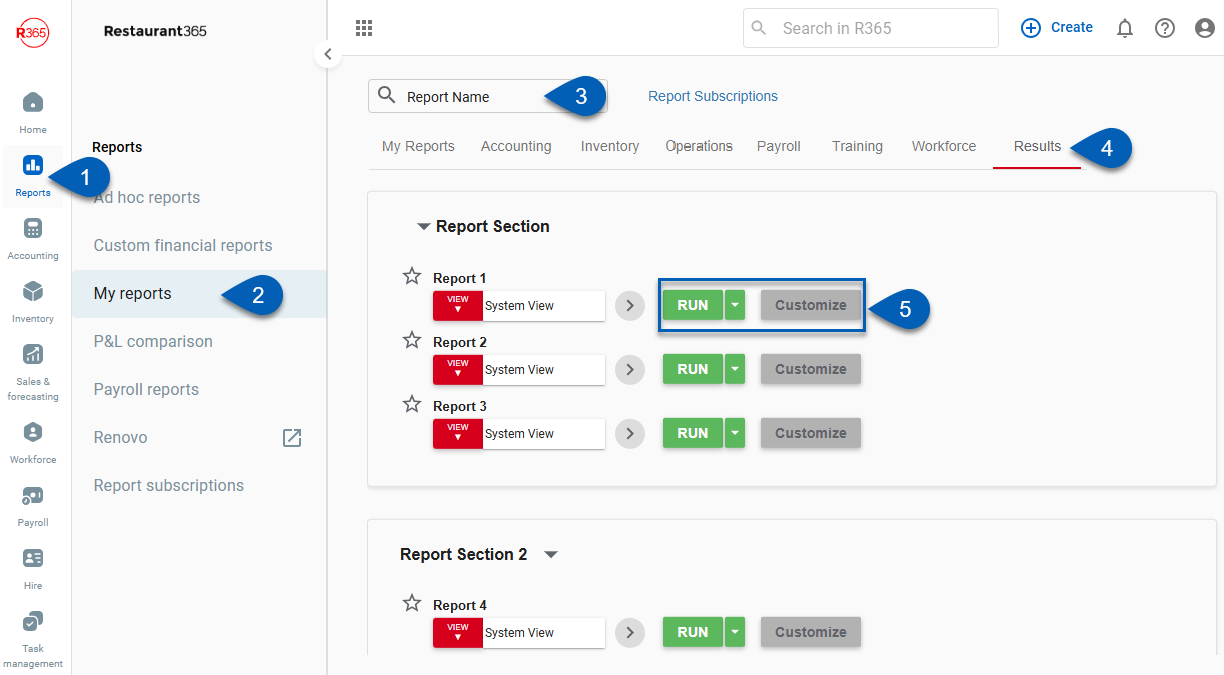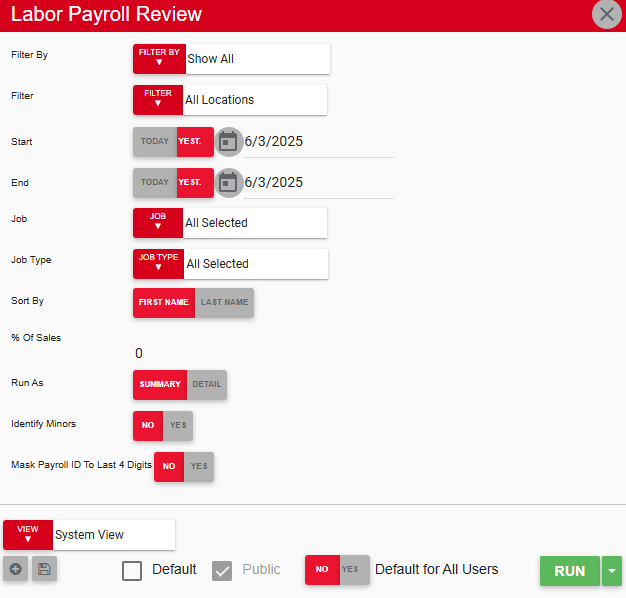The Labor Payroll Review searches the system for all labor punches within a selected date range. This comprehensive report is designed to help the Accounting Manager ensure that all labor data is accurately prepared and ready for submission to the payroll provider. By capturing detailed information on employee hours, pay rates, and total earnings, the Labor Payroll Review facilitates precise payroll processing. It also provides insights into labor costs, helps monitor compliance with labor laws, and identifies discrepancies between scheduled and actual hours worked.
This report includes both a summary and detailed version. Access the summary to see an overview of the employee's total hours or view the detailed report for a breakdown of labor punches by job.
While R365 provides labor information at no additional charge, your payroll provider might charge service fees. Please check with your provider before transferring data.
Navigation
The My Reports search bar can be used to search R365's entire catalog of reports.
- Open the Reports app.
- Navigate to My Reports.
- Enter all or part of the report name in the search bar.
- The Results tab will open with the list of search results.
- From beneath the report name, click Run to run the report with the selected report view.
-OR-
Click Customize to adjust the report parameters and run the report.

Report Parameters

Field | Description |
|---|---|
Filter By | A list of all filter categories. Filter categories will vary based by report. |
Filter | A list of filter options determined by the 'Filter By' category selected. |
Start | First date for which to pull data for the report. The 'Start' and 'End' parameters create the date range for the data generated. The report then displays data for all dates within the date range, including the start and end dates. |
End | Last date for which to pull data for the report. The 'Start' and 'End' parameters create the date range for the data generated. The report then displays data for all dates within the date range, including the start and end dates. |
Job | Jobs for which to generate data. Users can select one or more jobs to include in the report. |
Job Type | Labor operational reporting categories associated with the GL accounts assigned to jobs. Users can select one or more Job Types by which to filter the report. |
Sort By | Determines whether employees are sorted by First Name or Last Name. |
% of Sales | Percentage of sales to be taken for tips. |
Run As | If Summary is selected, the report displays an overview of total hours for each employee. |
Identify Minors | If set to Yes, the word 'Minor' appears next to all employees who are under a certain age. |
Mask Payroll ID to Last 4 Digits | If set to Yes, only the last four digits of the Payroll ID are shown in the report. |
View options | This section provides options to select, save, edit, or delete a report view. |
Run | Generates the report. Click the down arrow to the right of the Run button to export, email, or print the report. |
Report Columns

Column | Description |
|---|---|
Employee Name | Name of the employee. |
In | Time when the employee started the shift. |
Out | Time when the employee ended the shift. |
Location | Location where the employee worked the job. |
Job | Name of the job that the employee worked. |
Pay Rate | Employee's hourly rate of pay for the job. |
Reg Hrs | Number of hours worked at a regular rate (decimal, e.g. 4.25 = 4 hrs 15 min). |
OT Hrs | Number of hours worked at an overtime rate (decimal, e.g. 4.25 = 4 hrs 15 min). |
Double Time Hrs | Number of hours worked at a double time rate (decimal, e.g. 4.25 = 4 hrs 15 min). |
Tot Hrs | Total number of hours worked (decimal, e.g. 4.25 = 4 hrs 15 min). |
Reg Pay | Amount owed for regular hours. Reg Pay = Reg Hrs × Reg Rate. |
OT Pay | Amount owed for overtime hours. OT Pay = OT Hrs × OT Rate. |
DT Pay | Amount owed for double time hours. DT Pay = Double Time Hrs × Double Time Rate. |
Break Penalty | Indicates if penalty pay is owed due to break violations, based on Location Record settings. |
Break Penalty Pay | Amount owed due to break penalty. |
Split Shift | Indicates if a split shift was worked, based on Location Record settings. |
Split Shift Pay | Amount owed due to split shift. |
Other Pay | Amount owed for reasons not covered by regular, overtime, double time, or penalty pay (as recorded on DSS). |
Total Labor Pay | Total owed for the date, including regular, overtime, double time, penalty, and other pay. |
Gross Receipts | Sum of all sales the employee participated in for the shift. |
% of Sales | Percentage of sales taken for tips. % of Sales = Gross Receipts × Percentage of Sales. |
Charge Tips | Tips from credit card sales, as reported by the system. |
Declared Tips | Tips from cash sales, as declared by the employee and reported by the POS. |
Tips to Payroll | Displays either % of Sales or (Charge Tips + Declared Tips), whichever is greater. |
Labor Hours and Labor $ values will not consider any hours or dollars associated with employees who have the Exclude Labor Hours and Exclude Labor $ checkboxes checked on their employee record.
Email, Export, or Print the Report

This report can be emailed, exported, or printed in custom formatting directly from the reporting window. Click here to learn how to send, export, or print this report.